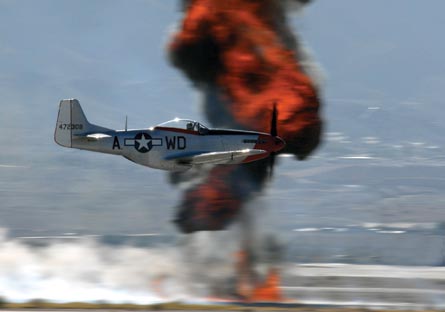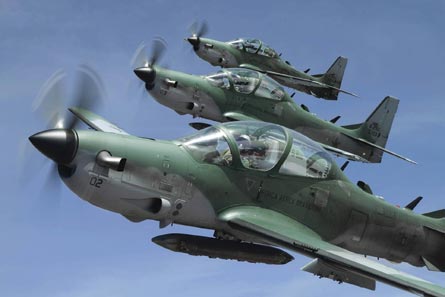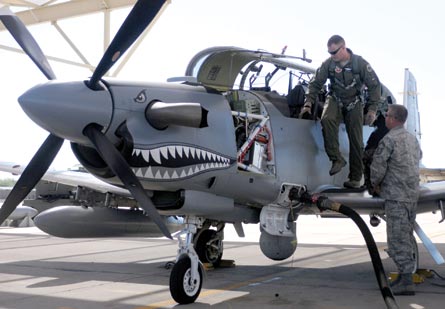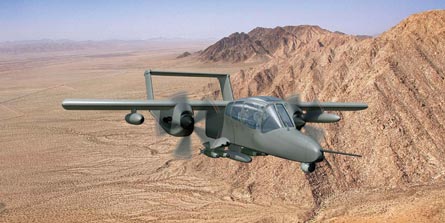Bringing back the propeller-driven fighter in the age of counterinsurgency may seem to some a belated no-brainer or to others a wasteful diversion with potentially suicidal risk to the pilot.
As late as early 2008, the leadership of the US Air Force sided firmly with the sceptics. Lt Gen Donald Hoffman, then the USAF's top-ranking acquisition official, implied to a group of reporters in April of that year that the idea of deploying propeller-driven aircraft in modern combat is too risky.
"We can rebuild the [North American] P-51 - great airplane," said Hoffman, citing the propeller-driven Second World War fighter. Then, however, the former Lockheed Martin F-16 pilot pointed at each of the journalists. "All we need is you, you, you and you to go fly it into the threat zone," he said.
|
|---|
It is this combination that drove the type out of the USAF inventory immediately after the Vietnam war, with the retirements of the Douglas A-1 Skyraider, the Cessna O-2 Skymaster and the de Havilland C-7 Caribou.
Paradoxically, however, the propeller-driven aircraft's ability to fly low and slow for long periods is responsible for a rebirth of enthusiasm within the USAF since shortly after Hoffman made his remarks about reintroducing the P-51.
The USAF leadership's position on the light attack mission would quickly evolve in 2008, even as the service's top leadership was fired - partly for moving too slowly to support a counterinsurgency campaign in Afghanistan.
One year after Hoffman's remarks, new USAF chief of staff Gen Norton Schwartz struck a different tone while addressing the same topic during a 24 April 2009 lecture at the Brookings Institution think-tank.
"There is a legitimate need to talk about the light strike role and building partner capacity role," Schwartz said. "And we intend to have that discussion in the coming months."
From outright derision to open-minded interest, USAF policy on propeller-driven warplanes continues to evolve. Reintroducing a modern-day version of the A-1 Skyraider into the USAF combat fleet is still not a priority.
But the USAF is moving forward to begin acquiring propeller-driven aircraft for a variety of roles related to counter-insurgency.
Industry officials expect the USAF to soon issue requests for proposals for a "light air support" (LAS) aircraft that will be donated to the Afghan air force, and a light mobility aircraft that will join the USAF's airlift fleet.
By the end of 2013, a squadron of 15 propeller-driven trainers should become operational to prepare USAF advisers to train foreign pilots on similar aircraft. The contract is called the light attack and armed reconnaissance (LAAR) fleet, but USAF officials are clear the aircraft will not be designed or equipped for combat missions.
"The LAAR squadron will be training our aircraft pilots. It will not be deploying. While operated by the Air Combat Command, it will be operated in a training environment," says Steven "Gringo" Peak, a requirements chief for Air Combat Command.
The definition of LAAR as a training squadron with 15 aircraft may seem like a step forward for the cause of fielding a propeller-driven aircraft, but is actually a steep downgrade from the original vision.
A capabilities request for information published by the USAF in July 2009 called for a combat-coded wing with 100 aircraft that could enter service within three years. The document sparked a strong industry response.
Hawker Beechcraft teamed with Lockheed Martin to propose integrating the latter's digital cockpit for the A-10C with the airframe of the AT-6 Texan II. Embraer proposed the EMB-314 Super Tucano that was already being tested for the counterinsurgency role by the US Navy.
Meanwhile, Boeing proposed a new version of the OV-10 Bronco, which was retired nearly 20 years ago. More exotic concepts also appeared, including a proposed revival of the PA-48, which itself is a turboprop-powered version of the P-51 Mustang.
The concept for an irregular warfare wing, however, soon fell victim to a change of priorities driven by "fiscal realities", says Lt Col Jeffrey "Homer" Godfrey, an A-10 pilot and operations planner for Air Combat Command's requirements branch.
The requirement for LAAR was refocused on a single squadron charged with training USAF pilots on the tactics that they, in turn, can share with foreign pilots. Separately, the USAF defined a new capability for an OA-X platform, a light attack fighter that is not yet an approved requirement and has no funding.
|
|---|
"It is a concept and there are no current plans to pursue a fleet of OA-X aircraft," Peak says. "That was the genesis of what we were looking at last year."
He adds: "There may be some development down the road pending the success of the LAAR programme that makes the OA-X programme something that wants to be looked at in the future."
The new strategy follows the policy of the new chief of staff, Schwartz, who spoke of favouring the training role to the combat role at the Brookings speech in 2009.
"If we had a primary trainer that is for basic pilot training, that could be easily reconfigured into a light strike platform, and then you would have a cadre of instructors organic to those machines who not only did primary training for our air force but can sort of make that transition quickly to a building partner capacity role in the same airplane, same crew, perhaps folks who we have arranged to have language skills and so on as part of their repertoire, that is a very attractive way to approach solving this problem," Schwartz said last year.
The current strategy is closely aligned with Scwhartz's statement in 2009. A small group of pilots will be trained to serve as advisers, and a selected group of allies - starting with Afghanistan - will be encouraged to buy a US-built, propeller-driven fighter.
"The time is right for increasing the scope of this mission," Godfrey says.
If fiscal realities led to the postponement of launching the OA-X programme, the same issue could force the USAF to re-examine the decision. As options for a propeller-driven fighter were still being discussed, the Air Combat Command produced a 20-page document on 23 December 2008 called "OA-X Enabling Concept".
|
|---|
The paper cited a study earlier that year that said replacing one and a half squadrons of deployed fighters with an OA-X fleet would save $300 million a year in fuel operations costs.
More recently, an ongoing demonstration of the AT-6 by the USAF, which was ordered by Congress, produced similar savings figures, with USAF officials saying the AT-6 costs $600 an hour to operate.
The same mission flown by an F-16 costs $17,000 in fuel and maintenance, the USAF says. Those figures have persuaded both major competitors for the LAAR trainer contract and the Afghan LAS contract that the market for OA-X still exists.
"We have not taken our eye off of that OA-X enabling concept," says Derek Hess, Hawker Beechcraft's director for AT-6 programmes.
When Hess thinks of the potential of the AT-6, he looks far beyond the immediate opportunities to win the LAS contract for 20 aircraft and the LAAR contract for 15 aircraft. Instead, Hess recalls, surprisingly, the Northrop F-5, a lightweight, affordable fighter that was designed to be exported to US allies around the world.
Hess adds that the scale of the export market for propeller-driven aircraft may never equal the scale of the F-5 programme, which delivered more than 2,000 fighters from 1964 to 1989. The goal of the light attack fighter concept, however, is similar: provide allies with an affordable aircraft for the counter-insurgency mission.
But aerospace industry analysts are more sceptical about the potential of sales in this market. Forecast International, a Connecticut-based firm specialising in market analysis, predicts a demand for about 650 aircraft over the next 10 years between the Super Tucano and AT-6. "It's not a huge market," says Raymond Jaworowski, a senior aerospace analyst at Forecast.
On the other hand, Forecast has not factored in potential sales in the US market beyond about 250 T-6A Texan IIs on order as primary trainers for the USAF and US Navy.
But the need for tactical aircraft is growing even as the numbers in the USAF inventory are declining. By the end of the decade, both the USAF and USN project shortfalls of hundreds of fighters beneath even the reduced requirements. If funding is not available to buy more Lockheed Martin F-35s, which are projected to cost at least $60 million on average by the end of the decade, investing in a propeller-driven aircraft may become a more attractive option.
In addition to fighting insurgents, propeller-driven aircraft also could be used to support the USAF air sovereignty mission, patrolling the skies over major cities and critical infrastructure.
That explains the Lockheed/Hawker Beechcraft team's pursuit of more powerful armament for the AT-6, which would not be necessary for the LAAR trainer. In a briefing at the Air Force Association convention in September, Hess disclosed the AT-6 could be armed with a single-barrel version of the 25mm General Dynamics GAU-6 Avenger gatling gun in development for the F-35. The current area suppression weapons for the AT-6 are two .50cal gun pods mounted under the wing.
Embraer, meanwhile, has had discussions with French industry about a 20mm gatling gun for the Super Tucano, although it has no firm plans to supplement both .50cal guns installed inside the aircraft's wings.
|
|---|
Interest in a cannon-like weapon for both aircraft speaks to the emerging mission profile for the OA-X. In addition to providing armed overwatch of patrols, convoys and infiltration operations, the USAF's enabling concept proposes the OA-X should be called upon for strafing runs during the close air support of troops in contract and to protect downed pilots waiting to be rescued.
Both competing teams are also interested in equipping their aircraft with precision-guided, small munitions. With the combination of precision weapons and an on-board targeting sensor, such as the L-3 Wescam MX-15 electro-optical/infrared camera, the OA-X aircraft could supplement the role currently provided by armed unmanned aircraft systems. Unlike jet-powered fighters, a propeller-driven OA-X could loiter near a target for several hours without needing to refuel.
In the same "enabling concept" document drafted by the Air Combat Command, a combination of about 36 F-16s and F-15Es consume 190,500kg (420,000lb) of fuel provided by six tankers per day, and the tankers themselves require another 245,000kg.
The OA-X requirement, if moved forward, will look beyond new armament. It will be critical for the manufacturer to protect the crew from a range of small arms fire.
While infantry patrol wearing body armour and ride in blast-shielded vehicles, pilots in A-10s and AH-64s are enclosed in an armoured bubble.
|
|---|
Any aircraft the USAF selects for OA-X would need similar protection for flightcrew. "It's going to have to work in our normal requirement for any other aircraft that's going to go down-range," Peak says.
Embraer has equipped the Super Tucano with Kevlar and ceramic plates that protect the pilots from .50cal bullets, says Acir Padilha, vice-president of marketing and sales at Embraer Defense. The AT-6, by contrast, is protected with ceramic plates designed to stop a 7.62mm armour piercing incendiary round, Hess says.
The USAF has left open the option of pursuing an all-new aircraft that could be designed specifically for the OA-X, perhaps with heavier armour for the pilot. The USAF is clear that even if an acquisition process is launched for OA-X, it will not be a follow-on order to the winner of the LAS or LAAR contracts. "It would be a truly new-start programme," Peak says.
The focus is now on the pending contract awards. Schwartz signalled in his 2009 remarks that the ideal LAAR candidate would be based on an aircraft already performing a basic trainer role, which would seem to favour the AT-6 derivative of the USAF's existing primary trainer.
The USAF instead wants a "fair and open competition strategy to get the very best solution", Godfrey says.
Embraer's Padilha concedes that the Super Tucano may face political pressure in the LAS and LAAR contracts. The navy planned to deploy a leased Super Tucano to Afghanistan this year to conduct an operational assessment, but the project - called Imminent Fury phase 2 - was cancelled by Congress.
"It caught our attention," Padilha says. "We know that we have the best product. A fair competition must be in place."
 |
|---|
An AT-6 demonstrator has recently tested its countermeasures equipment. Picture: US Air Force |
Source: Flight International
























